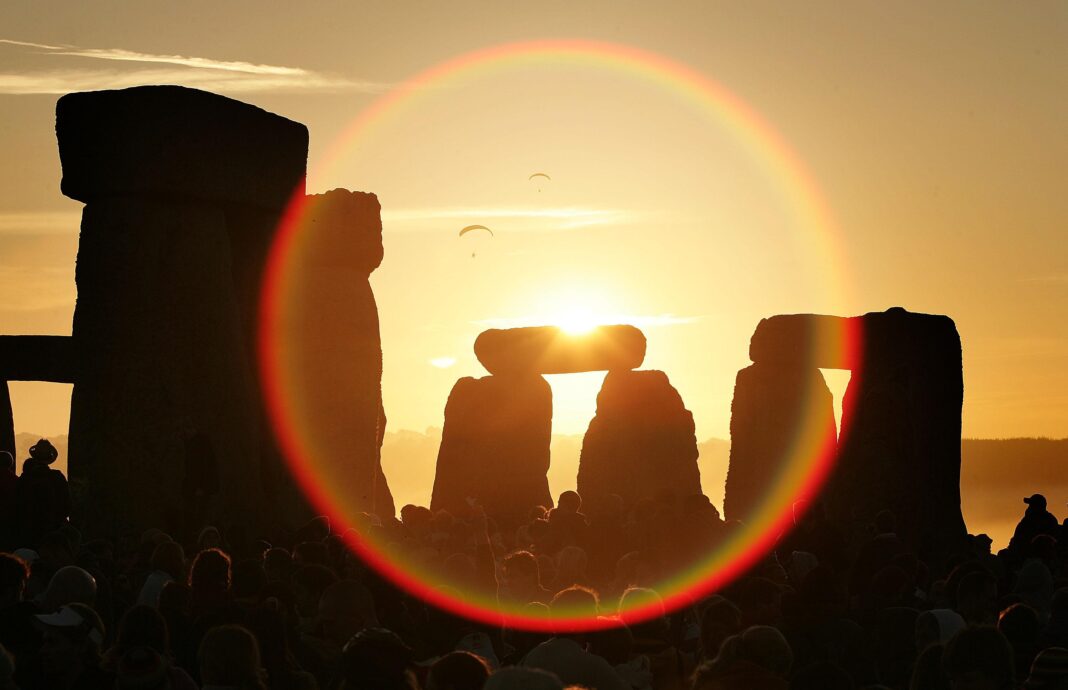Science See All The Naked-Eye Planets On The Summer Solstice And A Rare Venus-Moon Alignment: What You Can See In The Night Sky This Week Jamie Carter Senior Contributor Opinions expressed by Forbes Contributors are their own. I inspire people to go stargazing, watch the Moon, enjoy the night sky New! Follow this author to improve your content experience. Got it! Jun 19, 2022, 08:00pm EDT | Share to Facebook Share to Twitter Share to Linkedin People watch the midsummer sun as it rises over the megalithic monument of Stonehenge on June 21, .
. . [+] 2005 on Salisbury Plain, England.
Crowds gathered at the ancient stone circle to celebrate the Summer Solstice; the longest day of the year in the Northern Hemisphere. (Photo by Peter Macdiarmid/Getty Images) Getty Images Each Monday I pick out the northern hemisphere’s celestial highlights (mid-northern latitudes) for the week ahead, but be sure to check my main feed for more in-depth articles on stargazing, astronomy, eclipses and more. What To See In The Night Sky This Week: June 20-26, 2022 The beginning of the summer season in the northern hemisphere (and winter in the southern hemisphere) is an astronomical event—and it happens this week.
It’s best celebrated at sunrise—as is done at Stonehenge in the U. K. , which aligns with the rising Sun on the solstice—but this year there ’s a bonus view just before thanks to a chance alignment of the planets.
A few mornings later will be your last best chance to see those five naked-eye planets shining together until 2041, but there’s more. With the Moon waning we’re about to have short, but dark night skies ideal for seeing the arc of our own Milky Way galaxy. Get somewhere rural and look southeast after dark! Tuesday, June 21, 2022: Summer Solstice, five naked-eye planets and a Last Quarter Moon Today it’s the June solstice—summer solstice in the northern hemisphere, and winter solstice in the southern hemisphere—when the Sun will reach its most northerly, and highest, point in the sky during 2022.
It marks the first day of summer in the northern hemisphere and the first day of winter in the southern hemisphere. In the northern hemisphere, the days will now get shorter and the nights longer, which for stargazers is something of a relief. Recommended For You 1 New Research Finds A Connection Between Domestic Violence And These Two Personality Disorders More stories like this Fewer stories like this 2 This Scientist Helps Andean Forests And Ecuador’s Women In STEM More stories like this Fewer stories like this 3 Exceptional Fossil Preservation Suggests That Discovering Dinosaur DNA May Not Be Impossible More stories like this Fewer stories like this Solstice will occur at 09:05 Universal Time, which you can translate to your local time here .
It should be worth watching because Mercury, Venus, Mars, Jupiter and Saturn—as well as the First Quarter Moon—will all be visible in the east just before the “solstice sunrise. ” Great timing, solar system! Wednesday, June 22, 2022: Moon and Mars, Mercury and Aldebaran Stellarium Wednesday, June 22, 2022: Moon and Mars, Mercury and Aldebaran In the very early hours it will be possible to see in the east a waning Moon close to Mars and, just before sunrise, a tiny Mercury just above supergiant Aldebaran, the brightest star in the constellation of Taurus. At dawn on June 24th, the crescent Moon joins the planetary lineup.
It’s conveniently placed between . . .
[+] Venus and Mars, serving as a proxy Earth. Sky & Telescope illustration Friday, June 24, 2022: Planetary parade Get up before sunrise and cast your eyes to the southeastern horizon and you’ll be able to see Mercury lowest followed by Venus, Mars, Jupiter and Saturn across 107º of sky. It’s your last best chance to see all five naked-eye planets together in the night sky until 2041.
As a bonus there will also be a waning 19%-lit crescent Moon between Venus and Mars. Saturday, June 25, 2022: Venus, the Pleiades and a crescent Moon Stellarium Saturday, June 25, 2022: Venus, the Pleiades and a crescent Moon Here’s yet another good excuse to rise early—Venus , the brightest planet in the sky skirting the most beautiful naked-eye star cluster, the Pleiades, in the southeastern pre-dawn night sky. You can actually watch that event subtly change every morning this week.
The reason to wake-up early to see it today is because a slim 12% crescent Moon will form a triangle with Venus and the Pleiades. Look carefully and you’ll see Mercury and Aldebaran appear below the trio just before sunrise. Sunday, June 26, 2022: Venus and a crescent Moon Stellarium Sunday, June 26, 2022: Venus and a crescent Moon Get up early once more and you’ll be treated to the sight of a slender 6% crescent Moon hanging just 2.
5° from super-bright Venus. It’s the closest the two brightest objects in the night sky will get to each other in 2022. What a sight! Just above the pair will be the Pleiades, just below Mercury and Aldebaran.
Wishing you clear skies and wide eyes. Follow me on Twitter or LinkedIn . Check out my website or some of my other work here .
Jamie Carter Editorial Standards Print Reprints & Permissions.
From: forbes
URL: https://www.forbes.com/sites/jamiecartereurope/2022/06/19/see-all-the-naked-eye-planets-at-summer-solstice-as-milky-way-window-opens-what-you-can-see-in-the-night-sky-this-week/



